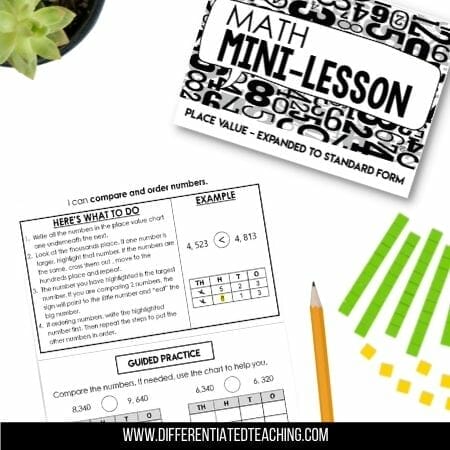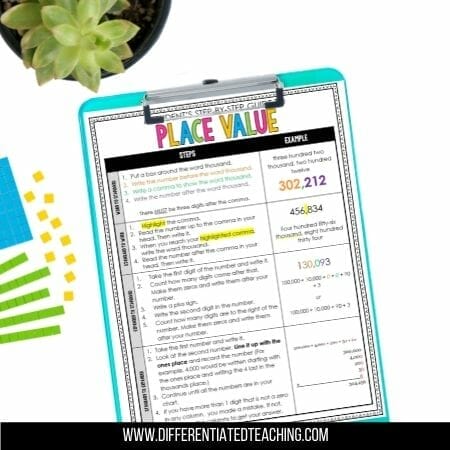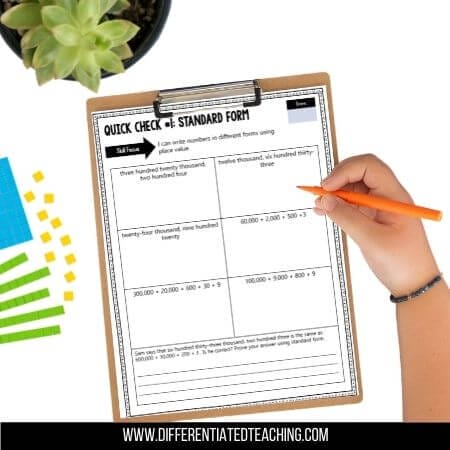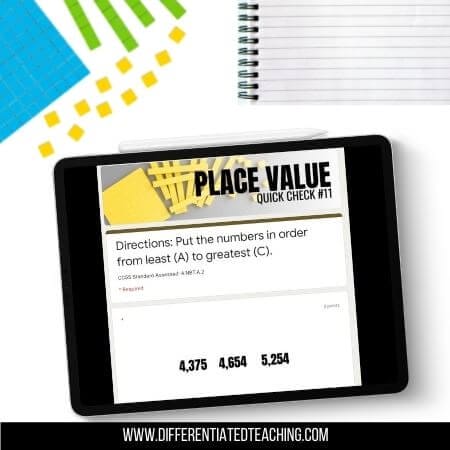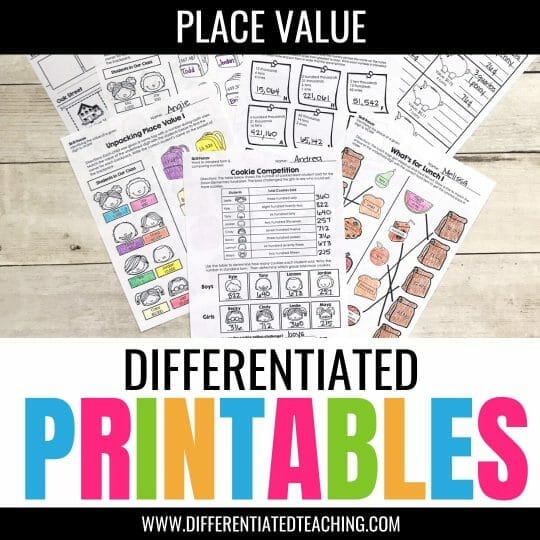The Easy Way to Teach Place Value to Help Struggling Learners
If you’ve landed here, you’re probably like me. You always find your learners struggle with place value. They come in with very different levels of understanding, and you spend a lot of time differentiating to meet their needs. I’ve got some great news! Over the years, I’ve figured out the easy way to teach place value to my struggling learners while waiting for their abstract reasoning to catch up to the requirements set by the state. What do I mean? Keep reading to learn more.

It can be a struggle to figure out how to teach place value for students struggling with the abstract thinking required to visualize really big (or really small) numbers. While most students can break down a three-digit number without math manipulatives, things get dicey once the numbers get larger.
While some students are ready for independent practice with only a short mini-lesson, others need lots of repeated exposure. These easy ways to teach place value have been a huge help for students struggling with the abstract nature of place value.
While these tips cannot replace conceptual understanding, they help students who might otherwise flounder build strategies and experience success until they internalize these math concepts and their understanding catches up with their procedural abilities.
The easy way to solidify place value basics & how to convert between number forms
As we dig into the strategies, please remember that most aren’t focused on conceptual understanding. Instead, they are designed to help students ready for the more abstract concepts. Many of my students struggled because they just tried to rush through the process and didn’t check their work. I found giving a step-by-step checklist like the one below was a great way to put a check system in place to avoid these issues.
These tips focus on step-by-step methods and using math tools and resources to make it easy to see the process. The strategies will help them build fluency with their ability to convert between number forms and compare and order numbers.
They aren’t a replacement for work with concrete manipulatives, like number disks or tiles, when you’re teaching place value. However, they can be a great tool for working with struggling learners who need a strategy to help them organize their thought processes. They can also be a big help when you’re working to plan place value interventions for struggling learners.
1) How to convert place value between standard and expanded form
Converting numbers from standard to expanded form is a key aspect of the Common Core Math Standards for students in grades 3-5. As they begin working with larger numbers, the challenge intensifies. The main difficulty lies in breaking down these numbers and keeping track of the value of each digit, especially when writing large numbers with many zeros. This can be particularly overwhelming for students who struggle with motor planning or dysgraphia.
However, there are effective and simple ways to help these students:
- Graph Paper:
- Benefit: Aids in accurately lining up zeros.
- Availability: Easy to print and free, making it a practical choice for classroom use. Access free graph paper.
- Multisensory Writing Pad:
- Features: Offers boxes for alignment, similar to graph paper, and includes color-coding. Here’s an example.
- Advantage: Helps students keep their work neat and properly aligned.
In response to the difficulties many students face with this conversion, I prepare in advance by having these special types of paper ready. This preparation ensures that when teaching this lesson, all students have the tools they need to succeed in mastering the conversion between standard and expanded forms.
Teaching Tips for Converting Standard to Expanded Form
When it comes to teaching my struggling students to convert from standard to expanded form, I like to teach them to use visual cues to ensure they’ve correctly written all the pieces of a multi-digit number.
Visual Cue Method for Conversion:
- Underlining Each Digit:
- Students begin by underlining each digit in the multi-digit number. This step helps them visually separate each digit, making it easier to identify its place value.
- Recording the First Digit:
- Students then write down the first digit (representing the largest place value).
- They count the number of underlines behind this digit, indicating how many zeros follow it in the expanded form.
Implementing the Method in Classroom:
- Guided Practice:
- Students initially practice these steps multiple times under guidance.
- This repetitive practice ensures they understand and can apply the method confidently.
- Independent Work:
- Once comfortable, students progress to working through these steps independently.
- This stage allows them to apply what they’ve learned autonomously, reinforcing their understanding.
- Error Analysis in Math Talks:
- I integrate an error analysis model during math discussions.
- This approach keeps the conversation engaging and builds conceptual understanding through collaborative problem-solving.
By utilizing this structured approach, students receive the support they need to master the conversion from standard to expanded form, enhancing their mathematical skills and confidence.
2) Converting place value between standard and word form.
In my classroom, I often encounter students facing challenges with converting between word form and standard form in place value. To support students who continue to struggle despite re-teaching, I implement a visual strategy as part of my Tier 1 intervention efforts.
Visual Strategy for Converting Between Word and Standard Forms:
- Focus on the Comma:
- The strategy emphasizes the importance of the comma in the conversion process.
- Students learn that a comma in word form corresponds to a comma in the same spot in the standard form number.
- Using Erasable Highlighters:
- At my small group station, we use erasable highlighters to emphasize commas.
- This helps students pay extra attention to the placement of commas.
Additional Support for Mastery:
- Highlighting the Word ‘Thousand’:
- If a student continues to struggle, I introduce boxing the word “thousand” in the word form.
- This further visual cue helps segment the number for easier understanding.
- Step-by-Step Process:
- Students underline and read the number before the boxed word “thousand”.
- They then replace “thousand” with a comma in their written form.
- The number after the box is then written, and the first digit of the next segment is crossed off.
- This process is repeated for all segments of the number.
Impact of the Visual Approach:
- This visual method has proven to be highly effective for my students.
- I consistently observe its utilization during our math practice sessions, indicating its effectiveness and ease of adoption.
By making the conversion process visual, students can better grasp the relationship between word form and standard form, leading to improved understanding and confidence in their mathematical abilities.
3) Converting numbers with zeros: a common challenge when teaching place value
encounter difficulties when zeros are involved in the conversion. To address this, I’ve developed two specific tricks to help my students check their work effectively.
Tricks for Checking Work in Number Conversion:
- From Expanded to Standard Form:
- Trick: Count the number of digits in the first part of the expanded form.
- Purpose: The counted digits indicate how many digits should be in the standard form answer.
- From Standard to Expanded Form:
- Trick: Count the number of non-zero digits in the standard form number.
- Purpose: The count determines the number of addends needed in the expanded form.
Application in Classroom Practice:
- These tricks serve as quick and efficient checks for students, ensuring accuracy in their conversions.
- By focusing on digit count and non-zero digits, students gain a clearer understanding of the relationship between expanded and standard forms, especially when zeros are part of the equation.
Implementing these straightforward strategies can significantly enhance students’ ability to self-check and correct their work, fostering greater independence and confidence in their mathematical skills.
Simplify Supporting Learners with this Place Value Cheat Sheet
In our classroom, we keep math journals to help organize our learning. In addition to differentiating the assignments and math centers I use for those struggling to master place value concepts, I also created a cheat sheet.
This printable aims to help my students remember the steps to converting numbers between different forms. I’d love to share it with you for free!
Assessing place value mastery – the most important piece of the puzzle
One of the most important things I do with my struggling students is using formative assessments or quick checks. If you’re unfamiliar with formative assessment, they aim to give you more information on the next steps for teaching and aren’t designed to be included in the grading process.
Since place value tends to be one of the most challenging things I teach all year, I immediately start assessing all students who receive a re-teach lesson. This helps me track who is mastering specific skills during my guided math groups. It also helps me ensure I am filling the gaps across the unit.
For some kids, this process continues as a Tier 1 intervention through guided math groups and mini-lessons spread across the next few units because they aren’t quite developmentally ready to leap to the abstract nature of place value and large numbers.
Here’s an example of one of the formative assessments I use in my class:
As you may notice, I always try to include one question that requires students to explain their thinking. This helps me see who has mastered the procedure and who truly understands the concept.
I recently created a digital version to support formative assessment during virtual learning. These are in Google Forms, which makes it easy because they are self-correcting!
Using the formative assessment data to differentiate while teaching place value
I have a set of 12 of formative assessments – two per skill – for my place value and money unit. This lets me recheck students who need additional guided practice and support after a few days.
Depending on my class, I’ve used these in two ways:
Option 1: Place Value Pre-Post Assessments
When I have a group that is really at different levels, I give one of these assessments before I teach the lesson to those students who are likely to have already mastered the concept.
This lets me know who has already mastered the skill so I can give them a project that requires them to apply their knowledge. This is a great way to build project-based learning into my math. This also allows me to teach the skill to a smaller group of students without boring the students who have already mastered it.
Option 2: Place Value Post-test & Retest
When I use the formative assessments this way, I give one as a quick check after teaching each lesson. This is typically how I do it when my whole class has weaker place value skills, and there aren’t students who have already mastered the unit objectives.
Once I see how students do on the formative assessment after the lesson, I build small groups and do re-teach. The small groups take the alternative version a few days after they’ve had additional opportunities to learn and practice the skill.
More Printable Activities and Classroom Resources to Help with Teaching Place Value?
While the strategies I mentioned above are not designed to replace the lessons you teach on the conceptual level, they can make a big difference for struggling learners in upper-grade levels. They will help students build procedural fluency while they continue to work through the abstract nature of learning place value.
If you need more support for your place value unit, I’ve created several resources and fun activities to help you out.
Click on the images to check them out now in my store.

